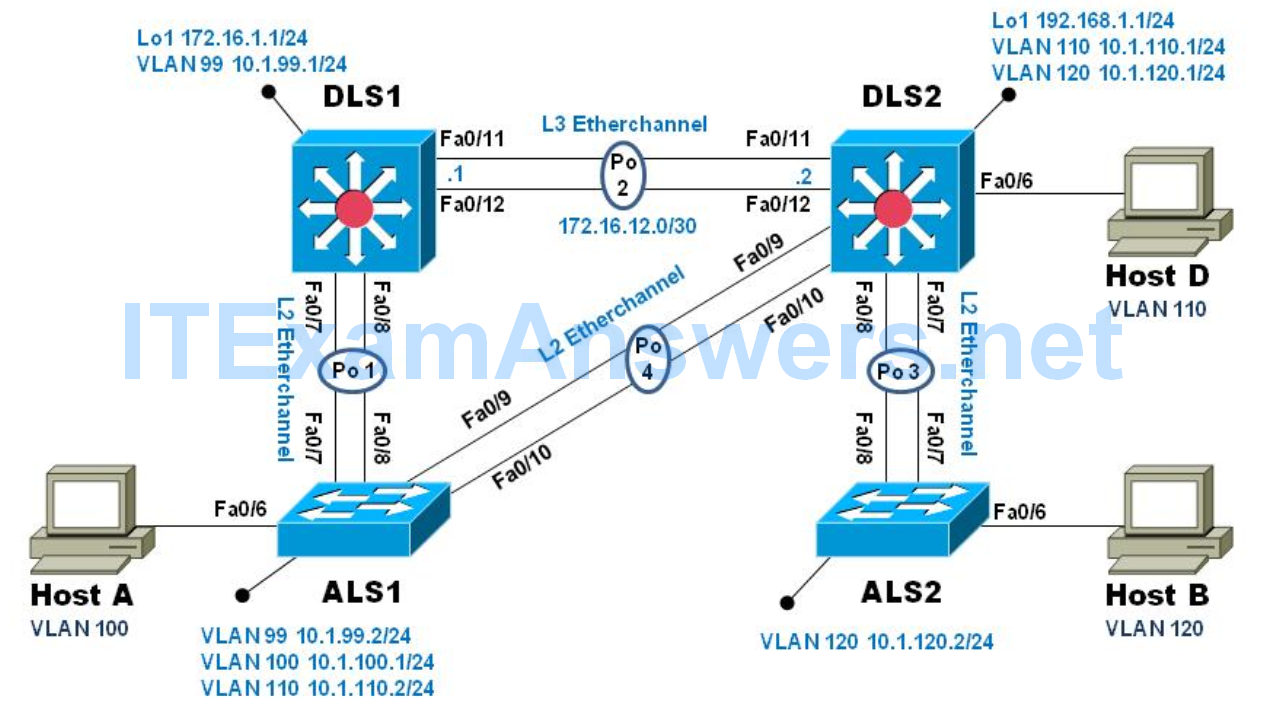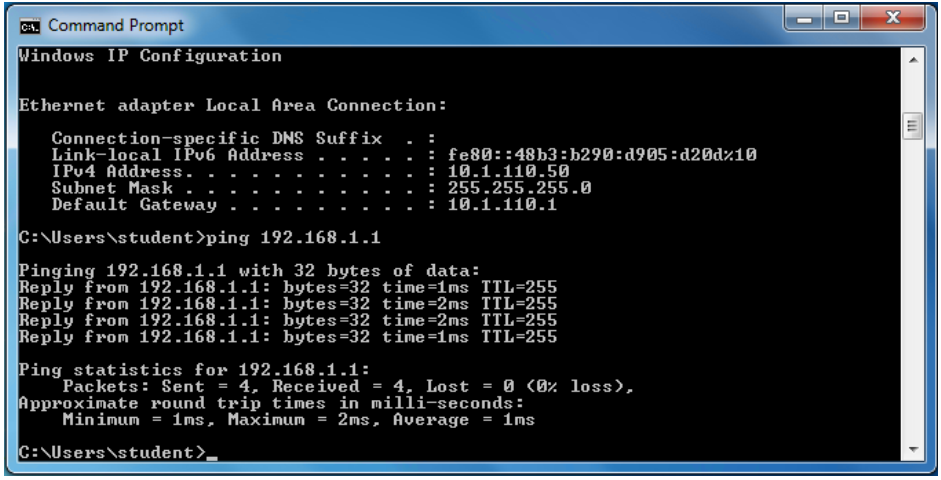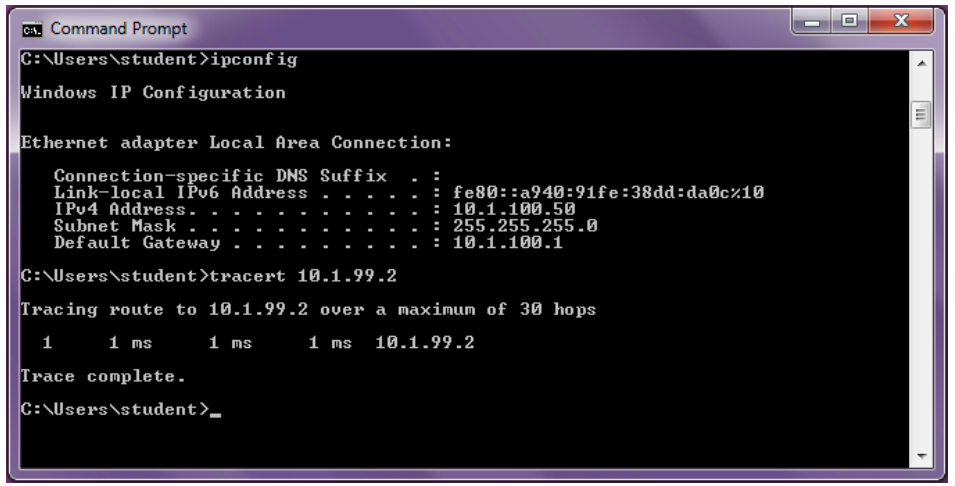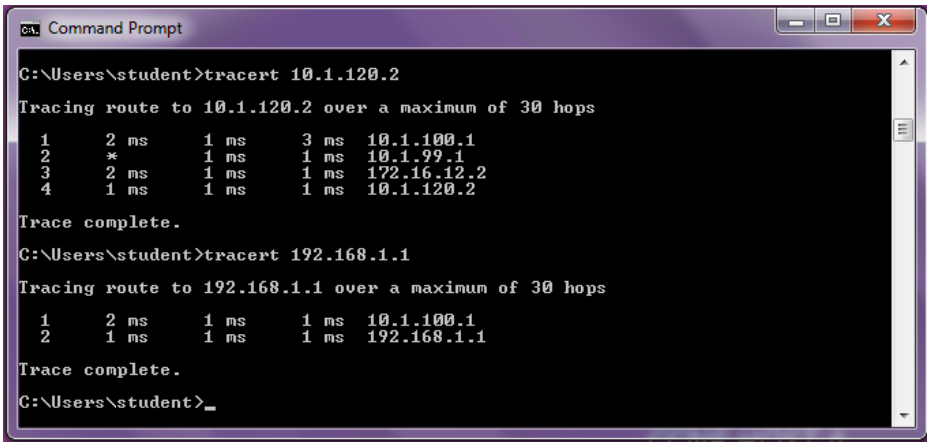Topology

Objectives
- Implement a Layer 3 EtherChannel
- Implement Static Routing
- Implement Inter-VLAN Routing
Background
Cisco’s switching product line offers robust support for IP routing. It is common practice to use only multi-layer switching in the distribution layer of the network, eliminating routers in all but special use cases, usually when a gateway interface is required. Doing so provides many benefits in terms of cost and manageability. In this lab you will configure Inter-VLAN routing on the multi-layer switches in your pod and then a Layer 3 EtherChannel link to interconnect them. You will further configure one of your access-layer switches to support basic routing, and apply static routes so that there is simple path control.
Note: This lab uses Cisco Catalyst 3560 and 2960 switches running Cisco IOS 15.0(2)SE6 IP Services and LAN Base images, respectively. The 3560 and 2960 switches are configured with the SDM templates “dualipv4-and-ipv6 routing” and “lanbase-routing”, respectively. Depending on the switch model and Cisco IOS Software version, the commands available and output produced might vary from what is shown in this lab. Catalyst 3650 switches (running any Cisco IOS XE release) and Catalyst 2960-Plus switches (running any comparable Cisco IOS image) can be used in place of the Catalyst 3560 switches and the Catalyst 2960 switches.
Required Resources
- 2 Cisco 2960 with the Cisco IOS Release 15.0(2)SE6 C2960-LANBASEK9-M or comparable
- 2 Cisco 3560v2 with the Cisco IOS Release 15.0(2)SE6 C3560-IPSERVICESK9-M or comparable
- Computer with terminal emulation software
- Ethernet and console cables
- 3 PCs with appropriate software
Part 1: Configure Multilayer Switching using Distribution Layer Switches
Step 1: Load base config
Use the reset.tcl script you created in Lab 1 “Preparing the Switch” to set your switches up for this lab. Then load the file BASE.CFG into the running-config with the command copy flash:BASE.CFG runningconfig. An example from DLS1:
DLS1# tclsh reset.tcl Erasing the nvram filesystem will remove all configuration files! Continue? [confirm] [OK] Erase of nvram: complete Reloading the switch in 1 minute, type reload cancel to halt Proceed with reload? [confirm] *Mar 7 18:41:40.403: %SYS-7-NV_BLOCK_INIT: Initialized the geometry of nvram *Mar 7 18:41:41.141: %SYS-5-RELOAD: Reload requested by console. Reload Reason: Reload command. <switch reloads - output omitted> Would you like to enter the initial configuration dialog? [yes/no]: n Switch> en *Mar 1 00:01:30.915: %LINK-5-CHANGED: Interface Vlan1, changed state to administratively down Switch# copy BASE.CFG running-config Destination filename [running-config]? 184 bytes copied in 0.310 secs (594 bytes/sec) DLS1#
Step 2: Verify switch management database configuration
At each switch, use the show sdm prefer command to verify the appropriate template is chosen. The DLS switches should be using the “dual ipv4-and-ipv6 routing” template and the ALS switches should be using the “lanbase-routing” template.
If any of the switches are using the wrong template, follow the procedures in Lab 1 to set the correct template and reboot the switch with the reload command.
Step 3: Configure layer 3 interfaces on the DLS switches
Enable IP Routing, create broadcast domains (VLANs), and configure the DLS switches with the layer 3 interfaces and addresses shown:
| Switch | Interface | Address/Mask |
|---|---|---|
| DLS1 | VLAN 99 | 10.1.99.1/24 |
| DLS1 | Loopback 1 | 172.16.1.1/24 |
| DLS2 | VLAN 110 | 10.1.110.1/24 |
| DLS2 | VLAN 120 | 10.1.120.1/24 |
| DLS2 | Loopback 1 | 192.168.1.1/24 |
| VLAN | Name |
|---|---|
| 99 | MGMT1 |
| 100 (ALS1 only) | LOCAL |
| 110 | INTERNODE |
| 120 | MGMT2 |
An example from DLS2:
DLS2(config)# ip routing DLS2(config)# vlan 110 DLS2(config-vlan)# name INTERNODE DLS2(config-vlan)# exit DLS2(config)# vlan 120 DLS2(config-vlan)# name MGMT2 DLS2(config-vlan)# exit DLS2(config)# int vlan 110 DLS2(config-if)# ip address 10.1.110.1 255.255.255.0 DLS2(config-if)# no shut DLS2(config-if)# exit DLS2(config)# int vlan 120 DLS2(config-if)# ip address 10.1.120.1 255.255.255.0 DLS2(config-if)# no shut DLS2(config-if)# exit DLS2(config)# int loopback 1 DLS2(config-if)# ip address 192.168.1.1 255.255.255.0 DLS2(config-if)# no shut DLS2(config-if)# exit DLS2(config)#
At this point, basic inter-vlan routing can be demonstrated using an attached host. Host D is attached to DLS2 via interface Fa0/6. On DLS2, assign interface Fa0/6 to VLAN 110 and configure the host with the address 10.1.110.50/24 and default gateway of 10.1.110.1. Once you have done that, try and ping Loopback 1’s IP address (192.168.1.1). This should work just like an external router; the switch will provide connectivity between two directly connected interfaces. In the output below, the switchport host macro was used to quickly configure interface Fa0/6 with host-relative commands:
DLS2(config)# int f0/6 DLS2(config-if)# switchport host switchport mode will be set to access spanning-tree portfast will be enabled channel group will be disabled DLS2(config-if)# switchport access vlan 110 DLS2(config-if)# no shut DLS2(config-if)# exit DLS2(config)#

Step 4: Configure a Layer 3 EtherChannel between DLS1 and DLS2
Now you will interconnect the multilayer switches in preparation to demonstrate other routing capabilities. Configure a layer 3 EtherChannel between the DLS switches. This will provide the benefit of increased available bandwidth between the two multilayer switches. To convert the links from layer 2 to layer 3, issue the no switchport command. Then, combine interfaces F0/11 and F0/12 into a single PAgP EtherChannel and then assign an IP address as shown.
| DLS1> | 172.16.12.1/30 | DLS2 | 172.16.12.2/30 |
Example from DLS1:
DLS1(config)# interface range f0/11-12 DLS1(config-if-range)# no switchport DLS1(config-if-range)# channel-group 2 mode desirable Creating a port-channel interface Port-channel 2 DLS1(config-if-range)# no shut DLS1(config-if-range)# exit DLS1(config)# interface port-channel 2 DLS1(config-if)# ip address 172.16.12.1 255.255.255.252 DLS1(config-if)# no shut DLS1(config-if)# exit DLS1(config)#
Once you have configured both sides, verify that the EtherChannel link is up
DLS2# show etherchannel summary
Flags: D - down P - bundled in port-channel
I - stand-alone s - suspended
H - Hot-standby (LACP only)
R - Layer3 S - Layer2
U - in use f - failed to allocate aggregator
M - not in use, minimum links not met
u - unsuitable for bundling
w - waiting to be aggregated
d - default port
Number of channel-groups in use: 1
Number of aggregators: 1
Group Port-channel Protocol Ports
------+-------------+-----------+-----------------------------------------------
2 Po2(RU) PAgP Fa0/11(P) Fa0/12(P)
DLS2# ping 172.16.12.1
Type escape sequence to abort.
Sending 5, 100-byte ICMP Echos to 172.16.12.1, timeout is 2 seconds:
.!!!!
Success rate is 80 percent (4/5), round-trip min/avg/max = 1/3/9 ms
DLS2#
Step 5: Configure default routing between DLS switches
At this point, local routing is supported at each distribution layer switch. To provide reachability across the layer 3 EtherChannel trunk, configure fully qualified static default routes at DLS1 and DLS2 that point to each other. From DLS1:
DLS1(config)# ip route 0.0.0.0 0.0.0.0 port-channel 2 %Default route without gateway, if not a point-to-point interface, may impact performance DLS1(config)# no ip route 0.0.0.0 0.0.0.0 port-channel 2 DLS1(config)# ip route 0.0.0.0 0.0.0.0 port-channel 2 172.16.12.2 DLS1(config)#
Once done at both ends, verify connectivity by pinging from one switch to the other. In the example below, DLS2 pings the Loopback 1 interface at DLS1.
DLS2# show ip route | begin Gateway
Gateway of last resort is 172.16.12.1 to network 0.0.0.0
S* 0.0.0.0/0 [1/0] via 172.16.12.1, Port-channel2
10.0.0.0/8 is variably subnetted, 2 subnets, 2 masks
C 10.1.110.0/24 is directly connected, Vlan110
L 10.1.110.1/32 is directly connected, Vlan110
172.16.0.0/16 is variably subnetted, 2 subnets, 2 masks
C 172.16.12.0/30 is directly connected, Port-channel2
L 172.16.12.2/32 is directly connected, Port-channel2
192.168.1.0/24 is variably subnetted, 2 subnets, 2 masks
C 192.168.1.0/24 is directly connected, Loopback1
L 192.168.1.1/32 is directly connected, Loopback1
DLS2#
DLS2# ping 172.16.1.1
Type escape sequence to abort.
Sending 5, 100-byte ICMP Echos to 172.16.1.1, timeout is 2 seconds:
!!!!!
Success rate is 100 percent (5/5), round-trip min/avg/max = 1/4/9 ms
DLS2#
Step 6: Configure the remaining EtherChannels for the topology
Configure the remaining EtherChannel links as layer 2 PagP trunks using VLAN 1 as the native VLAN.
| Endpoint 1 | Channel number | Endpoint 2 | VLANs Allowed |
|---|---|---|---|
| ALS1 F0/7-8 | 1 | DLS1 F0/7-8 | All except 110 |
| ALS1 F0/9-10 | 4 | DLS2 F0/9-10 | 110 Only |
| ALS2 F0/7-8 | 3 | DLS2 F0/7-8 | All |
Example from ALS1:
ALS1(config)# interface range f0/7-8
ALS1(config-if-range)# switchport mode trunk
ALS1(config-if-range)# switchport trunk allowed vlan except 110
ALS1(config-if-range)# channel-group 1 mode desirable
Creating a port-channel interface Port-channel 1
ALS1(config-if-range)# no shut
ALS1(config-if-range)# exit
ALS1(config)# interface range f0/9-10
ALS1(config-if-range)# switchport mode trunk
ALS1(config-if-range)# switchport trunk allowed vlan 110
ALS1(config-if-range)# channel-group 4 mode desirable
Creating a port-channel interface Port-channel 4
ALS1(config-if-range)# no shut
ALS1(config-if-range)# exit
ALS1(config)#end ALS1# show etherchannel summary
Flags: D - down P - bundled in port-channel
I - stand-alone s - suspended
H - Hot-standby (LACP only)
R - Layer3 S - Layer2
U - in use f - failed to allocate aggregator
M - not in use, minimum links not met
u - unsuitable for bundling
w - waiting to be aggregated
d - default port
Number of channel-groups in use: 2
Number of aggregators: 2
Group Port-channel Protocol Ports
------+-------------+-----------+-----------------------------------------------
1 Po1(SU) PAgP Fa0/7(P) Fa0/8(P)
4 Po4(SU) PAgP Fa0/9(P) Fa0/10(P)
ALS1# show interface trunk
Port Mode Encapsulation Status Native vlan
Po1 on 802.1q trunking 1
Po4 on 802.1q trunking 1
Port Vlans allowed on trunk
Po1 1-109,111-4094
Po4 110
<output omitted>
ALS1#
Step 7: Enable and Verify Layer 3 connectivity across the network
In this step we will enable basic connectivity from the management VLANs on both sides of the network.
- Create the management VLANs (99 at ALS1, 120 at ALS2)
- Configure interface VLAN 99 at ALS1 and interface VLAN 120 at ALS2
- Assign addresses (refer to the diagram) and default gateways (at DLS1/DLS2 respectively).
Once that is all done, pings across the network should work, flowing across the layer 3 EtherChannel. An example from ALS2:
ALS2(config)# vlan 120 ALS2(config-vlan)# name MGMT2 ALS2(config-vlan)# exit ALS2(config)# int vlan 120 ALS2(config-if)# ip address 10.1.120.2 255.255.255.0 ALS2(config-if)# no shut ALS2(config-if)# exit ALS2(config)# ip default-gateway 10.1.120.1 ALS2(config)# end ALS2# ping 10.1.99.2 Type escape sequence to abort. Sending 5, 100-byte ICMP Echos to 10.1.99.2, timeout is 2 seconds: ..!!! Success rate is 60 percent (3/5), round-trip min/avg/max = 1/3/8 ms ALS2# ALS2# traceroute 10.1.99.2 Type escape sequence to abort. Tracing the route to 10.1.99.2 VRF info: (vrf in name/id, vrf out name/id) 1 10.1.120.1 0 msec 0 msec 8 msec 2 172.16.12.1 0 msec 0 msec 8 msec 3 10.1.99.2 0 msec 0 msec * ALS2#
Part 2: Configure Multilayer Switching at ALS1
At this point all routing is going through the DLS switches, and the port channel between ALS1 and DLS2 is not passing anything but control traffic (BPDUs, etc).
The Cisco 2960 is able to support basic routing when it is using the LANBASE IOS. In this step you will configure ALS1 to support multiple SVIs and configure it for basic static routing. The objectives of this step are:
- Enable intervlan routing between two VLANs locally at ALS1
- Enable IP Routing
- Configure a static route for DLS2’s Lo1 network travel via Port-Channel 4.
Step 1: Configure additional VLANs and VLAN interfaces
At ALS1, create VLAN 100 and VLAN 110 and then create SVIs for those VLANs:
ALS1(config)# ip routing ALS1(config)# vlan 100 ALS1(config-vlan)# name LOCAL ALS1(config-vlan)# exit ALS1(config)# vlan 110 ALS1(config-vlan)# name INTERNODE ALS1(config-vlan)# exit ALS1(config)# int vlan 100 ALS1(config-if)# ip address 10.1.100.1 255.255.255.0 ALS1(config-if)# no shut ALS1(config-if)# exit ALS1(config)# int vlan 110 ALS1(config-if)# ip address 10.1.110.2 255.255.255.0 ALS1(config-if)# no shut ALS1(config-if)# exit ALS1(config)#
Step 2: Configure and test Host Access
Assign interface Fa0/6 to VLAN 100. On the attached host (Host A) configure the IP address 10.1.100.50/24 with a default gateway of 10.1.100.1. Once configured, try a traceroute from the host to 10.1.99.2 and observe the results.
In the output below, the switchport host macro was used to quickly configure interface Fa0/6 with hostrelative commands.
ALS1(config)# interface f0/6 ALS1(config-if)# switchport host switchport mode will be set to access spanning-tree portfast will be enabled channel group will be disabled ALS1(config-if)# switchport access vlan 100 ALS1(config-if)# no shut ALS1(config-if)# exit

The output from the host shows that attempts to communicate with interface VLAN 99 at ALS1 were fulfilled locally, and not sent to DLS1 for routing.
Step 3: Configure and verify static routing across the network
At this point, local routing (at ALS1) works, and off-net routing (outside of ALS1) will not work, because DLS1 doesn’t have any knowledge of the 10.1.100.0 subnet. In this step you will configure routing on several different switches:
At DLS1, configure:
- a static route to the 10.1.100.0/24 network via VLAN 99
At DLS2, configure
- a static route to the 10.1.100.0/24 network via VLAN 110
At ALS1, configure
- a static route to the 192.168.1.0/24 network via VLAN 110
- a default static route to use 10.1.99.1
Here is an example from ALS1:
ALS1(config)# ip route 192.168.1.0 255.255.255.0 vlan 110
ALS1(config)# ip route 0.0.0.0 0.0.0.0 10.1.99.1
ALS1(config)# end
ALS1# show ip route | begin Gateway
Gateway of last resort is 10.1.99.1 to network 0.0.0.0
S* 0.0.0.0/0 [1/0] via 10.1.99.1
10.0.0.0/8 is variably subnetted, 6 subnets, 2 masks
C 10.1.99.0/24 is directly connected, Vlan99
L 10.1.99.2/32 is directly connected, Vlan99
C 10.1.100.0/24 is directly connected, Vlan100
L 10.1.100.1/32 is directly connected, Vlan100
C 10.1.110.0/24 is directly connected, Vlan110
L 10.1.110.2/32 is directly connected, Vlan110
S 192.168.1.0/24 is directly connected, Vlan110
After configuring all of the required routes, test to see that the network behaves as expected.
From ALS1, a traceroute to 10.1.120.2 should take three hops:
ALS1# traceroute 10.1.120.2 Type escape sequence to abort. Tracing the route to 10.1.120.2 VRF info: (vrf in name/id, vrf out name/id) 1 10.1.99.1 0 msec 0 msec 0 msec 2 172.16.12.2 9 msec 0 msec 0 msec 3 10.1.120.2 0 msec 8 msec * ALS1#
From ALS1, a traceroute to 192.168.1.1 should take one hop:
ALS1# traceroute 192.168.1.1 Type escape sequence to abort. Tracing the route to 192.168.1.1 VRF info: (vrf in name/id, vrf out name/id) 1 10.1.110.1 0 msec 0 msec * ALS1#
Traces from Host A show an additional hop, but follow the designated path:

Step 4: End of Lab
Save your configurations. The switches will be used as configured now for lab 5-2, DHCP.
Device Configurations:
Below are the final configurations for each switch.
DLS1
DLS1# show run | exclude ! Building configuration... Current configuration : 2530 bytes version 15.0 no service pad service timestamps debug datetime msec service timestamps log datetime msec no service password-encryption hostname DLS1 boot-start-marker boot-end-marker no aaa new-model system mtu routing 1500 vtp mode transparent ip routing no ip domain-lookup ip domain-name CCNP.NET spanning-tree mode pvst spanning-tree extend system-id vlan internal allocation policy ascending vlan 99 name MGMT1 interface Loopback1 ip address 172.16.1.1 255.255.255.0 interface Port-channel1 switchport trunk encapsulation dot1q switchport trunk allowed vlan 1-109,111-4094 switchport mode trunk interface Port-channel2 no switchport ip address 172.16.12.1 255.255.255.252 interface FastEthernet0/1 shutdown interface FastEthernet0/2 shutdown interface FastEthernet0/3 shutdown interface FastEthernet0/4 shutdown interface FastEthernet0/5 shutdown interface FastEthernet0/6 shutdown interface FastEthernet0/7 switchport trunk encapsulation dot1q switchport trunk allowed vlan 1-109,111-4094 switchport mode trunk channel-group 1 mode desirable interface FastEthernet0/8 switchport trunk encapsulation dot1q switchport trunk allowed vlan 1-109,111-4094 switchport mode trunk channel-group 1 mode desirable interface FastEthernet0/9 shutdown interface FastEthernet0/10 shutdown interface FastEthernet0/11 no switchport no ip address channel-group 2 mode desirable interface FastEthernet0/12 no switchport no ip address channel-group 2 mode desirable interface FastEthernet0/13 shutdown interface FastEthernet0/14 shutdown interface FastEthernet0/15 shutdown interface FastEthernet0/16 shutdown interface FastEthernet0/17 shutdown interface FastEthernet0/18 shutdown interface FastEthernet0/19 shutdown interface FastEthernet0/20 shutdown interface FastEthernet0/21 shutdown interface FastEthernet0/22 shutdown interface FastEthernet0/23 shutdown interface FastEthernet0/24 shutdown interface GigabitEthernet0/1 shutdown interface GigabitEthernet0/2 shutdown interface Vlan1 no ip address shutdown interface Vlan99 ip address 10.1.99.1 255.255.255.0 ip http server ip http secure-server ip route 0.0.0.0 0.0.0.0 Port-channel2 172.16.12.2 ip route 10.1.100.0 255.255.255.0 Vlan99 line con 0 exec-timeout 0 0 logging synchronous line vty 0 4 login line vty 5 15 login end
DLS2
DLS2# show run | exclude ! Building configuration... Current configuration : 2905 bytes version 15.0 no service pad service timestamps debug datetime msec service timestamps log datetime msec no service password-encryption hostname DLS2 boot-start-marker boot-end-marker no aaa new-model system mtu routing 1500 vtp mode transparent ip routing no ip domain-lookup ip domain-name CCNP.NET spanning-tree mode pvst spanning-tree extend system-id vlan internal allocation policy ascending vlan 110 name INTERNODE vlan 120 name MGMT2 interface Loopback1 ip address 192.168.1.1 255.255.255.0 interface Port-channel2 no switchport ip address 172.16.12.2 255.255.255.252 interface Port-channel3 switchport trunk encapsulation dot1q switchport mode trunk interface Port-channel4 switchport trunk encapsulation dot1q switchport trunk allowed vlan 110 switchport mode trunk interface FastEthernet0/1 shutdown interface FastEthernet0/2 shutdown interface FastEthernet0/3 shutdown interface FastEthernet0/4 shutdown interface FastEthernet0/5 shutdown interface FastEthernet0/6 switchport access vlan 110 switchport mode access spanning-tree portfast interface FastEthernet0/7 switchport trunk encapsulation dot1q switchport mode trunk channel-group 3 mode desirable interface FastEthernet0/8 switchport trunk encapsulation dot1q switchport mode trunk channel-group 3 mode desirable interface FastEthernet0/9 switchport trunk encapsulation dot1q switchport trunk allowed vlan 110 switchport mode trunk channel-group 4 mode desirable interface FastEthernet0/10 switchport trunk encapsulation dot1q switchport trunk allowed vlan 110 switchport mode trunk channel-group 4 mode desirable interface FastEthernet0/11 no switchport no ip address channel-group 2 mode desirable interface FastEthernet0/12 no switchport no ip address channel-group 2 mode desirable interface FastEthernet0/13 shutdown interface FastEthernet0/14 shutdown interface FastEthernet0/15 shutdown interface FastEthernet0/16 shutdown interface FastEthernet0/17 shutdown interface FastEthernet0/18 shutdown interface FastEthernet0/19 shutdown interface FastEthernet0/20 shutdown interface FastEthernet0/21 shutdown interface FastEthernet0/22 shutdown interface FastEthernet0/23 shutdown interface FastEthernet0/24 shutdown interface GigabitEthernet0/1 shutdown interface GigabitEthernet0/2 shutdown interface Vlan1 no ip address shutdown interface Vlan110 ip address 10.1.110.1 255.255.255.0 interface Vlan120 ip address 10.1.120.1 255.255.255.0 ip http server ip http secure-server ip route 0.0.0.0 0.0.0.0 Port-channel2 172.16.12.1 ip route 10.1.100.0 255.255.255.0 Vlan110 line con 0 exec-timeout 0 0 logging synchronous line vty 0 4 login line vty 5 15 login end
ALS1
ALS1# show run | exclude ! Building configuration... Current configuration : 2630 bytes version 15.0 no service pad service timestamps debug datetime msec service timestamps log datetime msec no service password-encryption hostname ALS1 boot-start-marker boot-end-marker no aaa new-model system mtu routing 1500 vtp mode transparent ip routing no ip domain-lookup ip domain-name CCNP.NET spanning-tree mode pvst spanning-tree extend system-id vlan internal allocation policy ascending vlan 99 name MGMT1 vlan 100 name LOCAL vlan 110 name INTERNODE interface Port-channel1 switchport trunk allowed vlan 1-109,111-4094 switchport mode trunk interface Port-channel4 switchport trunk allowed vlan 110 switchport mode trunk interface FastEthernet0/1 shutdown interface FastEthernet0/2 shutdown interface FastEthernet0/3 shutdown interface FastEthernet0/4 shutdown interface FastEthernet0/5 shutdown interface FastEthernet0/6 switchport access vlan 100 switchport mode access spanning-tree portfast interface FastEthernet0/7 switchport trunk allowed vlan 1-109,111-4094 switchport mode trunk channel-group 1 mode desirable interface FastEthernet0/8 switchport trunk allowed vlan 1-109,111-4094 switchport mode trunk channel-group 1 mode desirable interface FastEthernet0/9 switchport trunk allowed vlan 110 switchport mode trunk channel-group 4 mode desirable interface FastEthernet0/10 switchport trunk allowed vlan 110 switchport mode trunk channel-group 4 mode desirable interface FastEthernet0/11 shutdown interface FastEthernet0/12 shutdown interface FastEthernet0/13 shutdown interface FastEthernet0/14 shutdown interface FastEthernet0/15 shutdown interface FastEthernet0/16 shutdown interface FastEthernet0/17 shutdown interface FastEthernet0/18 shutdown interface FastEthernet0/19 shutdown interface FastEthernet0/20 shutdown interface FastEthernet0/21 shutdown interface FastEthernet0/22 shutdown interface FastEthernet0/23 shutdown interface FastEthernet0/24 shutdown interface GigabitEthernet0/1 shutdown interface GigabitEthernet0/2 shutdown interface Vlan1 no ip address shutdown interface Vlan99 ip address 10.1.99.2 255.255.255.0 interface Vlan100 ip address 10.1.100.1 255.255.255.0 interface Vlan110 ip address 10.1.110.2 255.255.255.0 ip default-gateway 10.1.99.1 ip http server ip http secure-server ip route 0.0.0.0 0.0.0.0 10.1.99.1 ip route 192.168.1.0 255.255.255.0 Vlan110 line con 0 exec-timeout 0 0 logging synchronous line vty 0 4 login line vty 5 15 login end
ALS2
ALS2# show run | exclude ! Building configuration... Current configuration : 1933 bytes version 15.0 no service pad service timestamps debug datetime msec service timestamps log datetime msec no service password-encryption hostname ALS2 boot-start-marker boot-end-marker no aaa new-model system mtu routing 1500 vtp mode transparent no ip domain-lookup ip domain-name CCNP.NET spanning-tree mode pvst spanning-tree extend system-id vlan internal allocation policy ascending vlan 120 name MGMT2 interface Port-channel3 switchport mode trunk interface FastEthernet0/1 shutdown interface FastEthernet0/2 shutdown interface FastEthernet0/3 shutdown interface FastEthernet0/4 shutdown interface FastEthernet0/5 shutdown interface FastEthernet0/6 shutdown interface FastEthernet0/7 switchport mode trunk channel-group 3 mode desirable interface FastEthernet0/8 switchport mode trunk channel-group 3 mode desirable interface FastEthernet0/9 shutdown interface FastEthernet0/10 shutdown interface FastEthernet0/11 shutdown interface FastEthernet0/12 shutdown interface FastEthernet0/13 shutdown interface FastEthernet0/14 shutdown interface FastEthernet0/15 shutdown interface FastEthernet0/16 shutdown interface FastEthernet0/17 shutdown interface FastEthernet0/18 shutdown interface FastEthernet0/19 shutdown interface FastEthernet0/20 shutdown interface FastEthernet0/21 shutdown interface FastEthernet0/22 shutdown interface FastEthernet0/23 shutdown interface FastEthernet0/24 shutdown interface GigabitEthernet0/1 shutdown interface GigabitEthernet0/2 shutdown interface Vlan1 no ip address shutdown interface Vlan120 ip address 10.1.120.2 255.255.255.0 ip default-gateway 10.1.120.1 ip http server ip http secure-server line con 0 exec-timeout 0 0 logging synchronous line vty 0 4 login line vty 5 15 login end

not able to ping 10.1.120.2 from asl 1